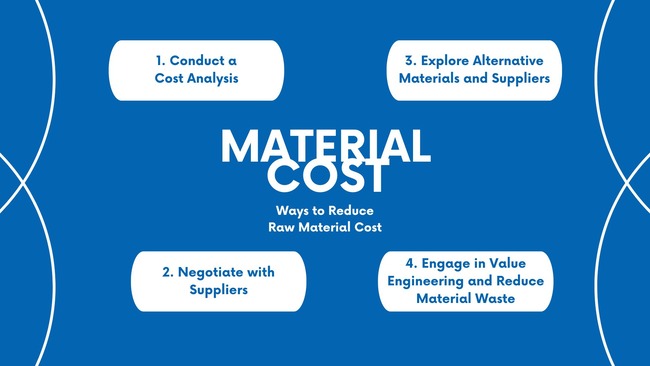How to Reduce Manufacturing Costs to Maximize Margins
- Date:
- Author: SVI Content Team
- Share:
Understanding manufacturing costs is crucial for determining product pricing and maximizing profits. These costs encompass a wide array of factors and the ability to effectively manage and reduce these costs can significantly impact the bottom line. It’s essential to grasp how to calculate manufacturing costs and identify ways to reduce costs in manufacturing.
If you don’t know how to reduce manufacturing cost, this blog will provide a clear guide on minimizing material and labor expenses in manufacturing. Without further delay, let’s explore the methods which can position companies for cost optimization and maximize your margins.
Part 1. Brief Overview of Manufacturing Costs
Manufacturing costs refer to the cost of production activities, i.e., the expenses incurred by an organization to manufacture a product. The costs are grouped into 3 main categories, including direct materials, direct labor and manufacturing overhead. Understanding and analyzing manufacturing costs is a crucial foundation for businesses to optimize their purchasing price and improve profit margins.
Importance of Manufacturing Cost Reduction:
The importance of reducing manufacturing costs cannot be overlooked, as it directly impacts a company’s profitability and competitiveness. By minimizing manufacturing costs, companies can:
- Increase profit margins and financial performance.
- Enhance competitiveness by offering competitive pricing.
- Improve cash flow to invest in initiatives that drive innovation and growth.
- Effective response to market fluctuations and economic challenges.
Check out the upcoming section for strategies to minimize manufacturing costs.
Part 2. How to Reduce Material Cost in Manufacturing
Raw materials serve as the building blocks of finished products in manufacturing processes. Given their direct impact on production expenses, optimizing raw material costs is paramount for sourcing materials efficiently and economically. How to reduce manufacturing costs of direct materials? Here are some actionable strategies on how to reduce manufacturing costs associated with direct materials.
1. Conduct a Cost Analysis
Begin by conducting a thorough cost analysis to evaluate the current expenses associated with raw materials. This helps businesses to identify whether they have fair pricing for the material. Next, identify key contributors to material costs based on the cost analysis report. This analysis enables prioritization of areas for cost reduction within the manufacturing process.
2. Negotiate with Suppliers
Establishing strong relationships with suppliers is important for negotiating favorable terms and pricing. When you have a thorough cost analysis report, you’ll be in a better position to negotiate competitive pricing, discounts or flexible terms. Effective negotiation tactics can significantly lower the factory price and improve your profitability.
3. Explore Alternative Materials and Suppliers
To lower manufacturing costs in raw materials, expand your sourcing horizon by researching and evaluating alternative materials suppliers that offer comparable performance at lower costs. Diversifying your supplier base provides access to competitive pricing and enhances supply chain resilience, further driving down raw material expenses.
4. Engage in Cost Engineering and Reduce Material Waste
Embrace waste reduction strategies such as lean manufacturing principles that focus on maximizing value while minimizing waste. It can help businesses achieve greater operational efficiency and cost savings. Additionally, implement cost engineering to optimize product designs and reduce material usage without compromising quality.
Part 3. How to Reduce Labor Costs in Manufacturing
Direct labor costs refer to the expenses that are paid to the worker directly involved in the production. They constitute a significant portion of production expenses, directly impacting product unit pricing. What measures can you take? Here are the effective ways to reduce manufacturing costs regarding labor.
1. Integrate Automation and Technology
Implementing technology and automation within production processes can improve productivity, leading to labor cost reduction as well as quality enhancement. Automation streamlines repetitive and manual tasks. It mitigates the risk of errors and improves overall efficiency. By leveraging technology, companies can optimize workflow processes, thereby reducing dependency on manual labor and realizing cost savings.
For large-volume orders, sourcing manufacturers that employ automated production methods can be particularly advantageous. Automated production is a preferred choice for handling high-volume production tasks because it increases productivity and effectively decreases labor costs.
2. Outsource Manufacturing Process
As labor costs in China are on the rise, exploring manufacturing options in countries with lower labor costs can benefit companies from cost reduction. Alternative manufacturing destinations beyond China like Vietnam, Cambodia, India and others offer more cost-effective labor rates. By outsourcing certain aspects of production to these locations, companies can capitalize on cost savings in labors
3. Streamline Production Processes
Identify and eliminate redundant activities to streamline production processes and reduce lead times. By rooting out inefficiencies, businesses can minimize labor layouts associated with excessive time spent on non-value-added tasks.
The production management team at SVI Global specializes in customized production and material supervision. Utilizing our expertise, we assist factories in evaluating and optimizing their production processes, plans, and quality control processes. These improve the efficiency of factories, reduce labor costs and shorten lead times, all while upholding uncompromising quality standards.
Part 4. Other Strategies to Reduce Manufacturing Cost
For companies engaged in international sourcing, reducing costs in manufacturing is of great concern. Here are some effective strategies.
1. Choose the Optimal Transportation Method
Shipping expenses can significantly contribute to production costs when delivering goods across borders. Opting for cost-effective transportation methods, such as ocean shipping, can lead to substantial savings. What’s more, choosing a reliable logistics company, and optimizing freight plans to reasonably arrange the quantity and stowage of goods can cut down logistics costs and shipping time.
2. Lower Duties and Taxes
Understanding relevant trade policies and regulations is essential for minimizing unnecessary tax expenditures. Companies can explore options such as applying for tax exemptions or reductions to mitigate duty and tax costs associated with international trade.
3. Manage Currency Exchange Rate Risk
The currency exchange rate is one of the factors affecting manufacturing costs. The fluctuations pose a common risk for companies engaged in international transactions. To mitigate this risk, businesses can utilize financial approaches such as foreign exchange options or currency swaps. These methods allow companies to lock in favorable exchange rates or hedge against potential losses due to currency fluctuations.
Part 5. Final Words
Learning how to reduce manufacturing costs is an essential step for companies seeking to enhance profitability and competitiveness. This blog has provided the best ways to reduce manufacturing costs to optimize profits for your development. Companies can diversify their supply chain, and build and manage supplier relationships to have good control over procurement costs.
Importantly, lowering manufacturing costs is not about cutting corners or sacrificing quality. Instead, it represents a strategic approach to fostering continuous improvement and sustainability within companies. By adopting cost-saving measures and optimizing operational efficiency, businesses achieve success and growth in the marketplace.
SVI Global stands ready to support you in implementing these strategies and achieving operational and financial objectives. At SVI Global, we understand the challenges of cost optimization in manufacturing. Our comprehensive sourcing services help companies streamline operations, find the optimal suppliers and get the most favorable terms, improve overall productivity, monitor product quality, and ensure on-time delivery. Partnering with SVI Global, we build a sustainable and promising prospect together.










